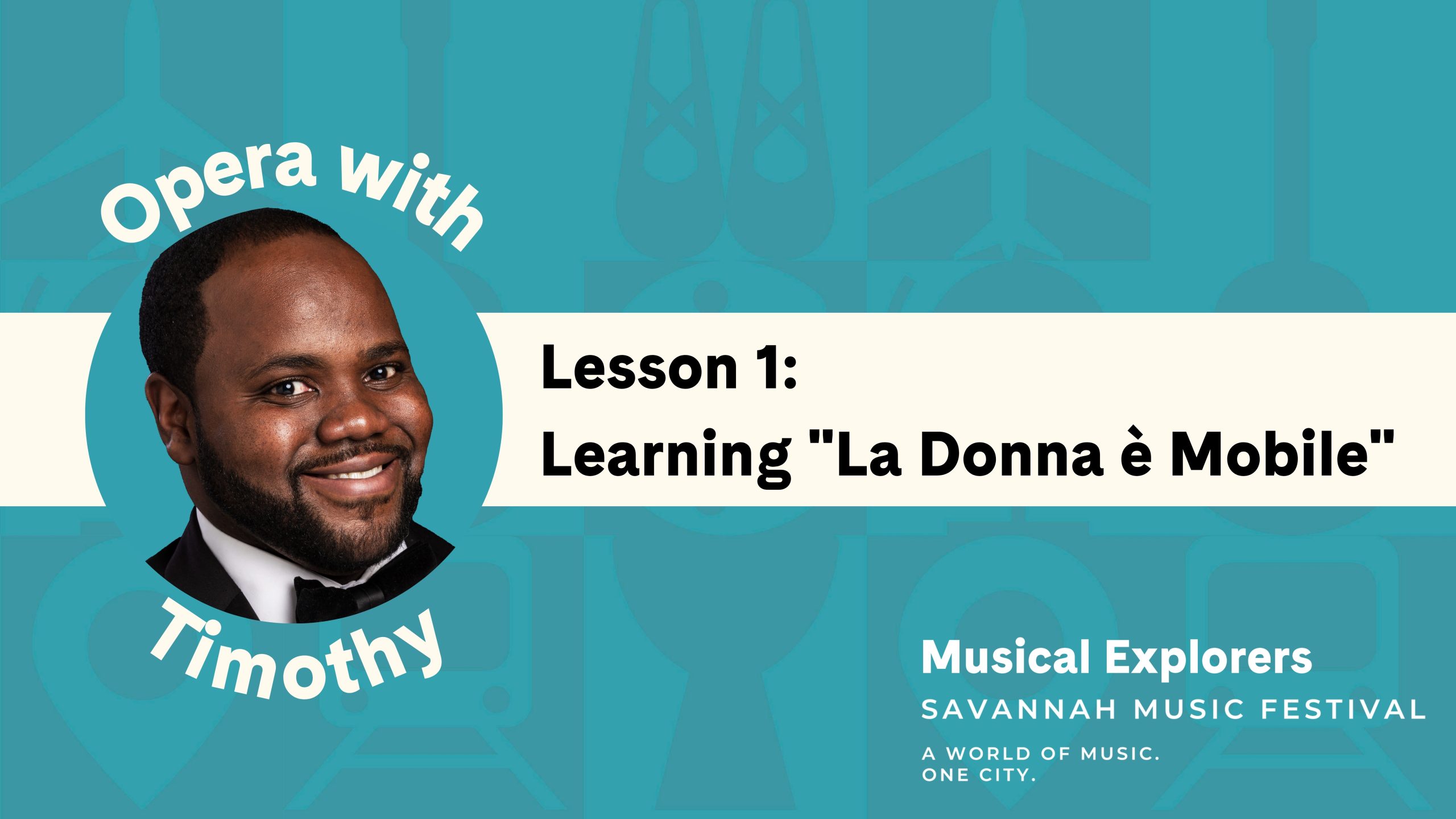Aim: What are some elements of opera singing?
Summary: Students will explore the elements of classical singing technique by listening to and learning “La Donna è Mobile.”
Materials: Musical Explorers digital resources
Standards: GA: ESGM2.PR.1, ESGM2.RE.1, ESGM2. CN.1, ESGM2.CN.2
SC: GM.PR.NL-AH.3, GM.RE.NL-AH.6, GM.RE.NL-AH.7, GM.CN.NL-AH.8, GM.CN.NL-AH.9
Vocabulary: aria, bass, legato, mezzo-soprano, opera, posture, repertoire, soprano, staccato, tenor, vibrato
Explore Opera
- Ask students what they know about opera; document as a class.
- Share that opera is a type of theatrical art form where everything is sung and set to music. Just like plays or movies, operas can be dramatic or comedic, but all of the dialogue is sung instead of spoken.
Ways We Can Use Our Voices
- Use SG 9 to have students discuss and explore the four ways we can use our voices.
- Lead a discussion with the class about the four different ways they can use their voices—whispering, talking, calling, and singing.
- Where would we use our whispering voice? (e.g., library or movie theater)
- Where would we use our talking voice? (e.g., classroom, telephone, or dinner table)
- Where would we use our calling voice? (e.g., baseball game, playing sports, or leading a group)
- Where would we use our singing voice? (e.g., Musical Explorers concert, car, or shower).
- Use SG 9 to have students discuss and explore the four ways we can use our voices.
- Have students explore each vocal quality by using the same sentence and pretending they are in some of the places identified above (e.g., “Hi, my name is …”).
Warming Up Our Voices to Sing
- Timothy is an opera singer, and he uses his singing voice to tell stories. Opera singers do not use microphones, their bodies ARE the microphones! They train their voices to project by using their breath and their body to sing over a full orchestra of instruments. The way a singer holds their body while they stand is called their posture.
- All singers use vocal warm-ups to keep their voices strong and healthy. Timothy warms up his voice by humming, singing nonsense words, and singing vowels both legato (smooth and connected) and staccato (short and choppy).
- Now that you have seen how Timothy warms up his voice, we can try singing along with teaching artist Shanna using the video below. These exercises are ones we can follow with our voices.
Listen to and Sing “La Donna è Mobile”
- There are four main voice categories for opera singers: soprano, mezzo-soprano, tenor, bass.
- Opera singers sing the songs that fit the voice category that feels the most comfortable to them. Every opera singer has songs and opera characters that they are prepared to sing. This is called their repertoire.
- Timothy is a tenor.
- Listen to Timothy perform “La Donna è Mobile,” Track 1.1.
- This aria, or solo song, is from the opera Rigoletto by Italian composer Giuseppe Verdi. It is about a woman who keeps changing her mind about who she loves. As you listen to Timothy sing, you will hear him use vibrato in his voice that helps him project his voice in a healthy way. Vibrato, the waves or movement you hear in some singing, is something that happens to voices naturally as the singer gets older, so when you are practicing singing, make sure you sing with your own unique voice!
Track 1.1 – “La Donna è Mobile” Song
- Listen to the chorus of “La Donna è Mobile,” Track 1.2.
Track 1.2 “La Donna è Mobile” Chorus
- Notice how there are short and long notes.
- Sing “La Donna è Mobile.” Remind students to use their breath and posture while singing and contrast the short and long notes by using their breath.
- How did you feel your breath change for the short and long notes?
Creative Extension: Parts of an Opera Production
Have your students work as a class to brainstorm as many jobs as they can think of that are important to creating an opera production. Share SG 10 to see if they came up with some of the same ideas.
- The composer writes the music for an opera.
- The producer oversees all aspects of an opera production, including hiring all of the musicians and workers.
- The librettist writes the story of the opera and the words to the music.
- The director tell the actors where to move on stage.
- The costume designer designs all of the costumes the singers wear on stage.
- The orchestra plays the instrumental music for the opera.
- The stage manager helps the performers communicate with the director and designers.
- The usher helps the audience to their seats.
- The audience enjoys the opera!
Using a tally, choose three of the jobs that students are interested in learning more about. Use the Literacy Links in Lesson 2 to read more about those jobs. Have students write a sentence and/or draw a picture of the opera job they are interested in, and why they think that it sounds interesting to them.
Musical Word Wall
Add the words aria, bass, breath, legato, mezzo-soprano, opera, posture, project, repertoire, soprano, staccato, tenor, and vibrato to the Musical Word Wall.
PDF Downloads
SG9 – Ways We Can Use Our Voices
SG10 – Parts of an Opera Production
Audio Tracks
Track 1.1 – “La Donna è Mobile” Song
Track 1.2 “La Donna è Mobile” Chorus
← Previous: Unit 1 – Meet Timothy

